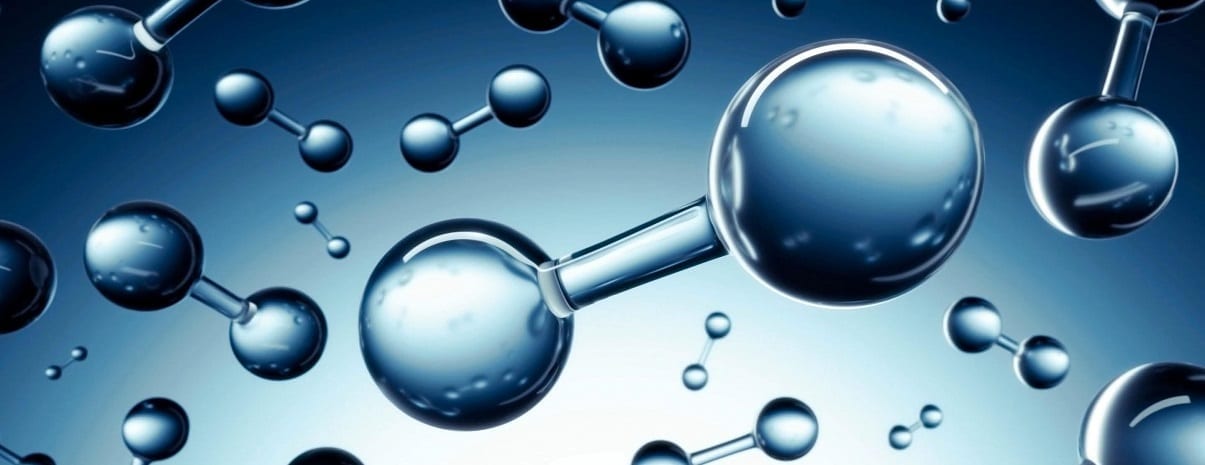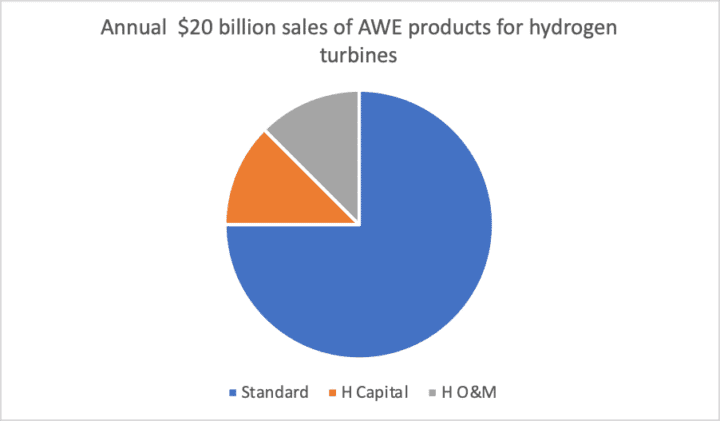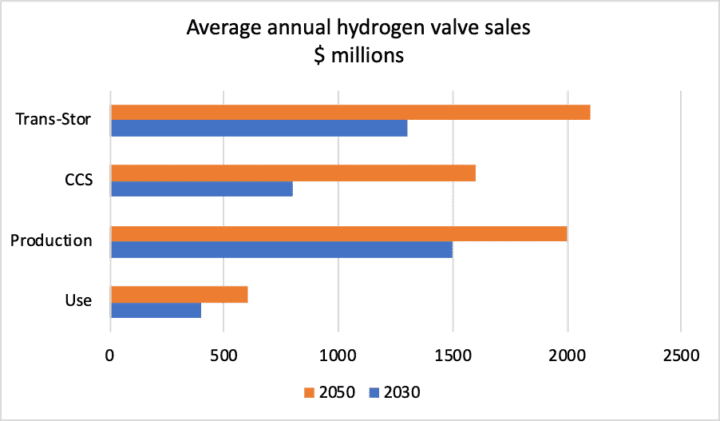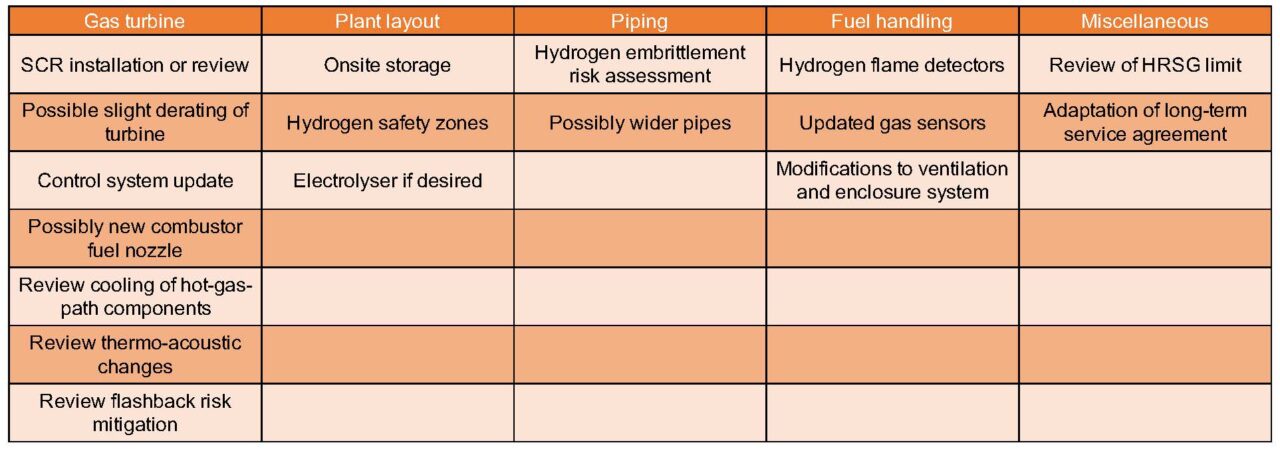Making the Best Decisions on Air, Water, and Energy Products Relative to Hydrogen Combustion

Power plants are planning very large investments in generators fueled by hydrogen, methane, mixtures, or ammonia. While hydrogen has the environmental advantage of zero carbon emissions, it has many disadvantages in terms of physical characteristics and safety.
The demand on the valves, compressors, burners, NOx control, and other air, water, energy (AWE) products and services is greater than when handling methane alone. The challenges can be met but it requires accessing disparate knowledge from many sources. This is possible with a new holistic approach.
Accurate forecasting is critical. The challenge is to anticipate all the potential political, environmental, and technological developments that will shape the market. The invasion of Ukraine by Russia adds a major variable. It is already affecting gas and oil prices, and is likely to change the time tables in meeting net-zero goals. With soaring gas prices in Europe, green hydrogen is temporarily more competitive than it was last month.
Investment in hydrogen AWE products will average less in the next 10 years than in the next 30 years. This is in part due to the plan, which does not prioritize short-term achievements. In fact, the higher near-term warming effect of methane is discounted because of its shorter life in the atmosphere.
The International Energy Agency (IEA) calculates that more than 1,800 GW of power plants fueled by hydrogen will be needed by 2050 in order to meet net zero. This would require an average annual capital investment of roughly $60 billion. Air/water/energy capital costs would be $10 billion/year. However, consumables, replacement, and repair parts would add another $10 billion.
Of this $20 billion per year, only about $5 billion would be products specifically designed for hydrogen (Figure 1). This includes different materials but also expanded sizes necessary to handle the hydrogen. Most AWE products will be purchased for production, transmission, or storage of the hydrogen and not for the actual use.
 1. Standard = conventional design, H capital = new products specially designed to handle hydrogen, H O&M = replacement products, consumables, and repairs for products designed for hydrogen. Source: Bob Mcilvaine
1. Standard = conventional design, H capital = new products specially designed to handle hydrogen, H O&M = replacement products, consumables, and repairs for products designed for hydrogen. Source: Bob McilvaineFor example, valve sales for actual hydrogen combustion will be less than $100 million per year. This is 15% of the annual use revenues. In the next 10 years, hydrogen valve sales will average more than $4 billion/year. Over the next 30 years, revenues will average more than $6 billion/year; $2 billion/year will be spent on valves for production-an equal amount will be spent on transmission and storage valves (Figure 2).
 2. Trans-Stor = transmission and storage valves, CCS = carbon capture and sequestration valves. Source: Bob Mcilvaine
2. Trans-Stor = transmission and storage valves, CCS = carbon capture and sequestration valves. Source: Bob McilvaineThe percentage of investment for compressors for hydrogen use compared to production, storage, and transmission is even less than with valves. The investment in compressors for carbon capture and sequestration (CCS) is substantial.
Transmission is the biggest application for pumps due to the need to liquefy the hydrogen. The CO2 must also be liquefied in CCS.
Production is the biggest market for air and liquid treatment. Molecular sieves are used to purify the hydrogen. Absorbers are needed to separate the CO2 in CCS processes.
The ability to use hydrogen impacts purchase decisions to a much greater degree than just the hydrogen ready components. Other impacts are:
- Purchase of Standard Components. If the decision is made to use a hydrogen-powered gas turbine plant rather than solar and battery storage, then the expenditure per MW for AWE products is much greater.
- Size of the Standard Products. The ultrapure water and selective catalytic reduction (SCR) systems are examples of standard components that will need to be bigger if hydrogen is the fuel.
There are extensive technical, regulatory, and business developments relative to hydrogen combustion. To better assimilate and utilize this new information a Hydrogen Combustion Industrial Internet of Wisdom Causation Loop has been created and is explained at: http://home.mcilvainecompany.com/images/Hydrogen_Causation_Loop.pdf
This loop provides easy access to available online information. There are many useful articles in back issues of POWER. These articles are easily accessed. New additions expand the loop continuously. Here are some examples:
CostTwo years ago, Sonal Patel, POWER staffer, asked how much hydrogen-based energy would cost and found some answers in a Hydrogen Council study. For an assumed import price of $3/kilogram of hydrogen, power produced from hydrogen turbines could cost about $140/MWh. In comparison, Lazard's November 2019 levelized cost of energy (LCOE) analysis suggests unsubsidized natural gas combined cycle generation today costs between $44/MWh and $68/MWh.
https://www.powermag.com/how-much-will-hydrogen-based-power-cost/
In 2022, producing 1 kilogram (kg) of green hydrogen can cost between $3 and $7, according to the IEA. That compares to $0.70-$1.60 for producing the same amount of hydrogen using natural gas, and up to $2.50 per kg using coal.
Many producers are optimistic that they can bring down the cost of hydrogen and make it competitive at least where other options are not viable. POWER magazine is reporting on large-scale green hydrogen projects, which promise major cost reductions
InnovationRich Voorberg, president of Siemens Energy North America, during a media call with POWER said, We are a pure play energy company. So, what that means is we go from one end to the other."
Siemens Energy also has a New Energy Business, or NEB, that is focused on the future, including on research and development (R&D) of hydrogen technology. NEB really focuses on what's next," Voorberg said.
Voorberg noted that Siemens Energy is also working with startup companies to help advance new technology. He said venture capitalists feed a lot of money into startups, but what they don't often do is help develop the technology or scale up products. We sit uniquely positioned between the startups and the customers on the other side," said Voorberg. We can go and talk to our customers, and say, Well, you've got this problem. We've got this startup. Let's the three of us come together and let's look at these different opportunities." This attitude toward rapid technology development is needed for the hydrogen initiative's success.
https://www.powermag.com/whats-next-for-siemens-energy/
DesignThere are a number of factors to consider when retrofitting a gas turbine system to burn hydrogen. If taken into account, hydrogen embrittlement of equipment is easily avoided. In the gas turbine, a new combustion system might need to be implemented, which would require new fuel accessory piping and valves. New fuel skids might also need to be installed to accommodate the smaller hydrogen molecule. Considerations have been summarized by Sebastian Mulder based on a recent survey performed by SS&A Power Consultancy (Table 1).
 Table 1. Summary of considerations when reconfiguring gas turbines to burn hydrogen-rich fuels. Courtesy: SS&A Power Consultancy GmbHAmmonia Use
Table 1. Summary of considerations when reconfiguring gas turbines to burn hydrogen-rich fuels. Courtesy: SS&A Power Consultancy GmbHAmmonia UseJapan is furnishing $500 million (59.8 billion yen) to much-watched projects that will develop and demonstrate 100% fuel ammonia combustion technology for gas turbines and 50% co-firing at coal boilers, as part of an effort to build out the nation's supply chain for fuel ammonia.
One of the biggest challenges ammonia combustion presents is that it burns at a rate approximately one-fifth that of natural gas, generates about half as much heat, and has an adiabatic flame temperature that is about 150C lower, according to IHI Corp. Scaling up also requires enlarging evaporators, control valves, and other peripheral equipment to increase gaseous ammonia injections into turbines-which potentially raise facility costs.
https://www.powermag.com/japan-bolsters-fuel-ammonia-combustion-at-gas-turbines-coal-boilers/
Biomass to HydrogenThe Babcock & Wilcox ClimateBright suite of technologies can capture CO2 and includes the ability to produce hydrogen. These technologies have application for a wide range of industries including energy production, food manufacturing, steel, cement, oil and gas, pharmaceutical, petrochemical, carbon black, and pulp and paper.
SCR DesignMitsubishi Power is developing a 40-MW ammonia-capable gas turbine with the belief that direct combustion may be better than multistage ammonia-cracking. To address NOx production, which is prompted by oxidation of ammonia's nitrogen component through its combustion, the commercialized gas turbine system will combine SCR with a newly developed combustor" that reduces NOx emissions.
https://www.powermag.com/mitsubishi-power-developing-100-ammonia-capable-gas-turbine/
Burner DesignA POWER magazine editorial reviews the direction headed by various turbine manufacturers to safely incorporate hydrogen for some or all of the fuel. One need is to minimize NOx emissions while maximizing efficiency. The major options are diffusion burning and dry low-NOx (DLN) technology, which pre-mixes air and fuel. The routes being selected by each turbine designer affect the conditions valves will encounter, the size of the pumps for water injection, and the need for SCR systems.
https://www.powermag.com/rediscovering-fire-advancements-in-gas-turbine-combustion/Compressors
CompressorsThe centrifugal integrally geared compressors in Sundyne's LMC/BMC/LF-2000 series are engineered to optimize the efficiency of hydrogen compression. Available from 100 cubic meters per hour (m3/hr) to 17,000 m3/hr these compressors are a popular choice for H2 gas applications.
Sundyne also offers a range of sealless pumps that are well-suited to this industry. Sundyne's magnetic drive sealless pumps reduce the danger of emissions or leaks. Ethylene tetrafluoroethylene (ETFE)-lined ANSIMAG pumps or HMD metallic pumps offer proven solutions for pumping caustic liquids.
CatalystsModern catalysts, when combined with recent advances in SCR system design, can achieve ultra-low NOx emissions, according to Lance Meeker of Wood. His article laid out some of the retrofit challenges.
Ball ValvesAmmonia as a liquid presents challenges for valve suppliers. In an August 2021 article, George Packard of Gemini Valve analyzes two- and three-piece ball valve options.
Leak DetectionTeledyne FLIR has expanded its acoustic imaging category with the Si124-LD, specific for compressed air leak detection. Relative to hydrogen, Teledyne uses CO2 as a tracer gas.
Artificial IntelligenceGE Digital Autonomous Tuning software uses artificial intelligence (AI) to build a machine learning (ML) digital twin model of a gas turbine to continuously find optimal flame temperatures and fuel splits to minimize emissions and acoustics. The on-premises software senses changes in ambient temperature, gas fuel properties, and degradation, and sends real-time automatic adjustments to the controls every two seconds.
By moving customers from optimizing their combustion systems manually, autonomous tuning unlocks additional emissions and fuel savings for accelerating their decarbonization goals," Martha Saker, digital product manager of GE Digital's Power Generation and Oil & Gas business, told POWER. What's more, applying AI/ML eliminates frequent intervention, moving customers a step closer to realizing the autonomous plant." With the additional complexity of hydrogen, autonomous tuning is even more important.
https://www.powermag.com/new-ge-digital-software-designed-to-optimize-gas-turbine-performance/
POWER conducted a webinar on Jan. 20, with John Villali, IDC research director, and Linda Rae, general manager of Power Generation and Oil & Gas at GE Digital, discussing How digital operations and data are transforming the industry to accelerate the energy transition." For this update, Villali was asked for his views on hydrogen. He replied, Hydrogen has the potential to play a significant role in the energy transition and global efforts to move from fossil fuels to clean energy. There is growing momentum and interest in the use of hydrogen to help reduce CO2 and combat climate change. That said, hydrogen will have its challenges in becoming a mainstream source of energy. The economics in storing and producing hydrogen will need to improve, as well as the process in which hydrogen is made. Currently the production of hydrogen largely relies on fossil fuels (6% of natural gas and 2% of coal used globally is utilized for hydrogen production). Scaling hydrogen infrastructure for greater adoption is also a challenge. That said, there are growth opportunities for hydrogen as large investments are being made to find cleaner ways to produce hydrogen and to build the hydrogen infrastructure needed to produce and consume hydrogen at scale. If those challenges can be met, hydrogen has a promising future as one of the cleanest forms of energy on its own."
The webinar details are found at:
In a white paper available on POWER's website, Mitsubishi Power explores ways to leverage massive amounts of data to maximize overall performance. Key takeaways include:
- The need for remote support technology at power plants is still accelerating.
- TOMONI HUB expands the onsite operations and maintenance (O&M) staff virtually with a team of experts on demand.
- Live support and automated advanced analytics use real-time data to diagnose issues and provide recommendations.
https://powermag.tradepub.com/free/w_defa2127/?p=w_defa2127
An additional whitepaper covers Mitsubishi Power's unique validation approach and the resulting gas turbine reliability. Due to the complexities of hydrogen combustion, these white papers take on a new meaning.
https://powermag.tradepub.com/free/w_defa765/?p=w_defa765
ABB Ability Genix Industrial Analytics and AI Suite, can help extend asset life, smooth process performance, promote safety and sustainability, and optimize supply chains.
https://www.powermag.com/white-papers/abb-ability-industrial-analytics-and-ai-suite/
An article entitled Troubleshooting Issues and Eliminating Headaches Related to Control Valves" is relevant because hydrogen will present many new issues. Sean Raymond of Emerson describes a systematic approach and commented, When troubleshooting control issues, it is important to keep an open mind and look beyond the obvious. It is human nature to blame the last thing changed' for any new problem that occurs. While erratic control valve behavior might be the apparent source of concern, the true cause is usually located elsewhere."
https://www.powermag.com/troubleshooting-issues-and-eliminating-headaches-related-to-control-valves/
The upgrading of controls at existing power plants will be necessary when combusting hydrogen. An example of the upgrades is the Municipal Electric Authority of Georgia (MEAG Power). It is modernizing and optimizing operations at its Wansley Unit 9 combined cycle power plant with Emerson's Ovation software, which will help to digitally transform the Georgia plant through more flexible operations, improved process efficiency, and enhanced cybersecurity.
https://www.powermag.com/press-releases/emerson-to-modernize-georgia-power-plant-for-reliable-affordable-energy/
These articles when integrated with other intelligence will help continually determine the options and total cost of ownership for utilizing hydrogen to meet net-zero goals. The challenge for suppliers is to validate the lower total cost of ownership for superior products. Articles can be supplemented by white papers and webinars in the validation process.
-Bob Mcilvaine (rmcilvaine@mcilvainecompany.com) is president of Mcilvaine Company.
The post Making the Best Decisions on Air, Water, and Energy Products Relative to Hydrogen Combustion appeared first on POWER Magazine.